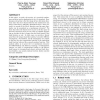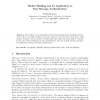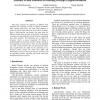CRYPTO
2006
Springer
14 years 8 months ago
2006
Springer
HMAC was proved in [3] to be a PRF assuming that (1) the underlying compression function is a PRF, and (2) the iterated hash function is weakly collision-resistant. However, recent...
CHES
2008
Springer
14 years 8 months ago
2008
Springer
Abstract. The security challenges posed by RFID-tag deployments are wellknown. In response there is a rich literature on new cryptographic protocols and an on-tag hash function is ...
CCS
2008
ACM
14 years 8 months ago
2008
ACM
We propose a new real-time authentication scheme for memory. As in previous proposals the scheme uses a Merkle tree to guarantee dynamic protection of memory. We use the universal...
CCS
2008
ACM
14 years 8 months ago
2008
ACM
In this paper, we study the security of a practical randomness extractor and its application in the tls standard. Randomness extraction is the first stage of key derivation functi...
ASIACRYPT
2008
Springer
14 years 8 months ago
2008
Springer
The collision-resistance of hash functions is an important foundation of many cryptographic protocols. Formally, collision-resistance can only be expected if the hash function in f...
ASIACRYPT
2008
Springer
14 years 8 months ago
2008
Springer
This paper studies the application of slide attacks to hash functions. Slide attacks have mostly been used for block cipher cryptanalysis. But, as shown in the current paper, they ...
CRYPTO
1995
Springer
14 years 10 months ago
1995
Springer
We introduce a new technique for constructing a family of universal hash functions. At its center is a simple metaphor: to hash a string x, cast each of its words into a small numb...
PKC
2000
Springer
14 years 10 months ago
2000
Springer
A number of signature schemes and standards have been recently designed, based on the Discrete Logarithm problem. In this paper we conduct design validation of such schemes while t...
ACSC
2001
IEEE
14 years 10 months ago
2001
IEEE
This paper analyses the efficiency of different data structures for detecting overlap in digital documents. Most existing approaches use some hash function to reduce the space req...
CTRSA
2006
Springer
14 years 10 months ago
2006
Springer
Vaudenay recently proposed a message authentication protocol which is interactive and based on short authenticated strings (SAS). We study here SASbased non-interactive message aut...





